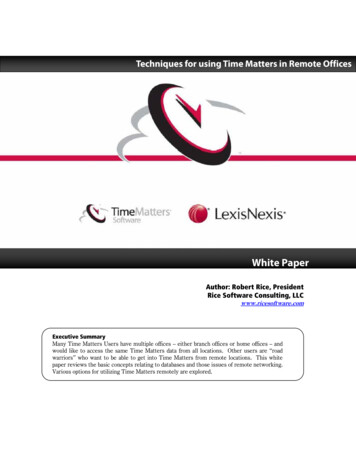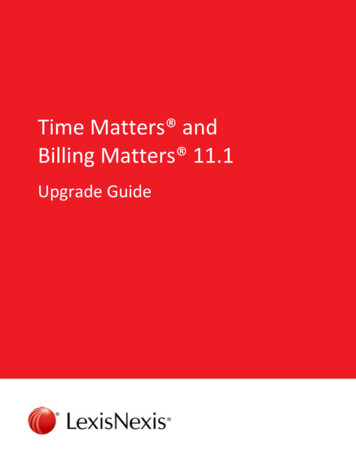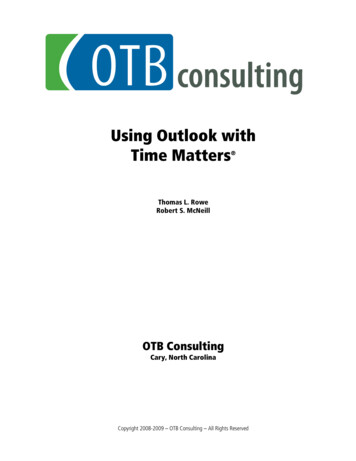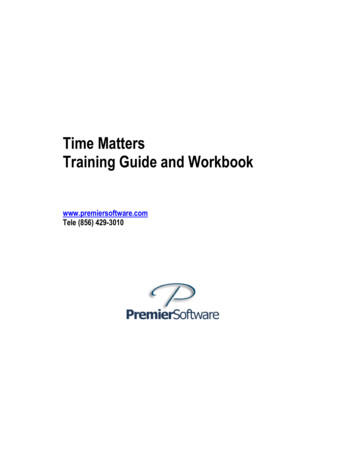
Transcription
Techniques for using Time Matters in Remote OfficesWhite PaperAuthor: Robert Rice, PresidentRice Software Consulting, LLCwww.ricesoftware.comExecutive SummaryMany Time Matters Users have multiple offices – either branch offices or home offices – andwould like to access the same Time Matters data from all locations. Other users are “roadwarriors” who want to be able to get into Time Matters from remote locations. This whitepaper reviews the basic concepts relating to databases and those issues of remote networking.Various options for utilizing Time Matters remotely are explored.
Copyright Notice This White Paper is copyrighted by Rice Software Consulting, LLCAcknowledgments Citrix is a registered trademark of Citrix Systems, Inc in the United States and other countries. GoToMyPC is a trademark, or registered trademark of Citrix Online, LLC, in the United Statesand other countries. Oracle is a registered trademark of Oracle Corporation. PCAnywhere is a trademark of Symantec Corp. LexisNexis, the Knowledge Burst logo, Shepardize, Lexis, and CheckCite are registeredtrademarks, and LEXLink is a trademark of Reed Elsevier Properties, Inc. used under license Time Matters and the Cloud Clock logo are registered trademarks of LexisNexis, a division ofReed Elsevier Inc. Windows, SQL Server and MSDE are either registered trademarks or trademarks of MicrosoftCorporation in the United States and/or other countries.Rice Software Consulting, LLC3509 East Park Blvd.Suite 180-147Plano, TX 75074Tel: 214-340-1114Fax: 972-384-2241http://www.ricesoftware.comCopyright 2004
Copyright 2004 - Rice Software Consulting, LLCTime Matters White PaperTechniques for using Time Matters in Remote OfficesBefore discussing methods of using Time Matters in remote offices, we must first understand howdatabases work across various networks.Primer on Data TransferAll networks transfer electronic packets of data between two or more computers. Not all networks arecreated equal, however. The transfer rate (known as the bandwidth) of a network can vary greatlydepending on the type of network and the equipment involved. There are many types of networks.The standard network found in most offices is known as a LAN (Local Area Network). Most LANsconsist of a Server, Workstations, cabling and a hub or digital switch. Most LANs today operate at aspeed of 100Mbs.When a computer connects to another computer or to a LAN that is not physically located in the sameoffice, this is known as a WAN (Wide Area Network). To create a WAN, the remote computer mustattach to the hosting system using a telecommunication connection such as dial-up, ISDN, DSL or T-1line. These different technologies each have varying speeds of transmission. WAN speeds across anyof these connections tend to be anywhere from 1/100th to 1/400th the speed of a LAN. This inherentslowness of WANs is a limiting factor for databases (like Time Matters) operating across a WANconnection. To understand why WAN speeds limit the performance of databases, we must firstunderstand how databases flow across networks.Databases are the programs most affected by slower connections since databases contain much moredata than a standard e-mail, work processing document, or webpage. Databases are made up ofcollections of data tables organized in logical groups. In Time Matters, for example, all Contacts aregrouped together in a Contacts table. Databases fall into two categories ISAM and Client/Server. Theway that these two categories transfer data is very different and greatly affects how a databaseoperates across slower connections. ISAM (Indexed Sequential Access Method) databases transfer theentire data table to the workstation across the network. Client/Server databases only transfer therecords that have been requested and thus operate faster over much slower connections since less datais actually moved across the connection. ISAM databases therefore use more data bandwidth thanClient/Server databases. Time Matters supports both ISAM and Client/Server databases. The TimeMatters Professional Edition runs on an ISAM database and the Enterprise Edition runs on aClient/Server database engine.The following graphics show the issue relating to data transfer over a slower network connection:DATAWorkstationNETWORK SERVERIn this example the connection between the network server and the workstations is wide –representing a normal 100Mbs LAN connection. The large amounts of data easily fit through the pipeand are not hindered by the bandwidth. In this scenario both ISAM and Client/Server database areacceptable. It is important to mention that having many users can also clog the available bandwidthwith data transfer.Techniques for using Time Matters in Remote Offices - 3
Copyright 2004 - Rice Software Consulting, LLCDATADATATime Matters White PaperDATADATADATAWorkstationNETWORK SERVERIn this example the bandwidth is more limited representing with a WAN connection or a LANconnection that is not sufficiently fast or is clogged with traffic from many users. The data does noteasily fit through the pipe in one transfer and consequently less data is transferred each second. Theresult is slowness and program instability.The trick then is to be able to run Time Matters over a connection that is 1/100th the speed of a LANconnection with the same speed and reliability that is inherent with a LAN connection. Not an easytask to say the least. There are some options:Built-In Option-Synchronization:All Editions of Time Matters have a built-in synchronization function. Synchronization allows a maindatabase to create a special copy known as a “clone” that can be transferred to a remote site. Theclone and the main database can be synchronized to incorporate any changes from the other. Thisoption does not take place in real-time and is thus not limited by network bandwidth. The changes arealways incorporated on a cycle that must be manually performed on both sides. At this time, there isno easy way to safely create an automatic procedure to initiate a scheduled synchronization.Advantages: Free – already built into Time MattersWorks wellRelatively easy to use once set up and trainedCan be done via E-mail eliminating the need for a WANDisadvantages: Not real-time (only as up-to-date as the last synchronization)Must be performed manually on both sides (potential for human error)Real-Time Solutions:There are three options to allow remote offices to run Time Matters in real-time across a WAN. Allthe options are based on the Enterprise Edition of Time Matters. Time Matters comes in two editions;Professional and Enterprise. The Professional Edition is based on an ISAM database. The Enterpriseedition is based on a Client/Server database (Currently Microsoft SQL Server – including the freeMSDE version of SQL ,Oracle, or PostgreSQL.) Client/Server databases are different from traditionaldesktop databases because they are designed especially for speed across low-speed connections (likethe Internet) by shifting the data processing burden to the server and away from the desktop. Withnormal databases, the desktop requests records and the entire database is packaged and shipped to thestation, which requires a high-speed network connection (such as found in a local area network).Client/Server databases only ship the requested records, thus shrinking the transmission requirementsand allowing the database to function over a much slower speed connection than would otherwise bepossible. This does mean that the server must be much more powerful than would otherwise benecessary since it shoulders the main processing burden.Techniques for using Time Matters in Remote Offices - 4
Copyright 2004 - Rice Software Consulting, LLCTime Matters White PaperOption 1:Time Matters Enterprise Edition running via remote control:In recent years there has been a proliferation of remote control software. Terminal Services, CitrixMetaframe, PCAnywhere and GoToMyPC.com are popular versions of remote control software.Remote control software are computer programs whereby the processing burden is further shifted tothe server making the desktop computer nothing more than a “dummy box” which sends its mousemovements and keystrokes to the server computer. Remote control programs lower the amount ofdata that flows between the server and the desktop even more since only clicks, keystrokes and screenrefreshes are sent and the data remains on the server. This helps overcome the bandwidth limitation.Notes: Requires only DSL speeds but a T1 would be recommendedBroadband is needed on both sides of the connectionMay still be too slow with many users hitting the system at the same timeRaises the bar on hardware requirements even moreNeeds well-versed network specialist/expert to advise, setup and maintain so as not to opentoo many holes in the security of the networkOnly supported where the host is owned by the client and the hosting is done from the client'ssite. Contract/off-site hosting is not supported.Option 2:Time Matters Enterprise using Microsoft SQL Server Replication:Microsoft SQL Server has a built-in function that allows replication of its databases over the Internet toother MS SQL Servers.This function known as “replication” is similar to the internal“synchronization that Time Matters does. Thus the Main Office could send Branch Office 1 andBranch Office 2, a copy of the starting database and then the offices could automatically send changesback and forth on a set schedule (every 15 minutes, every 45 minutes, every three hours, etc.). Thismerge replication occurs seamlessly in the background without end user intervention. This meansthat changes made in one office would always be behind the other offices by at least a few minutes. Thetime difference is called the latency of the connection and is affected by the speed of the servers andthe speed of the connection between the servers. The latency between two branch offices could befairly high (could be on the order of a few hours) since the changes would first be routed through thecentral office. Replication setup for many remote offices can be challenging and an outside networkand/or SQL specialist might need to be consulted regarding the exact setup.SQL Replication has some strong advantages in that both sides (Main Office and Branch Office) havetheir own separate databases thereby reducing performance issues relating to network speed (as longas the hardware in all offices is up to specification.) Replication can be set for a very short latency sothat only a small lag time will exist between the offices. The servers of all offices still need to bepowerful, but not as powerful as if using Terminal Services since the burden would be divided amongthe servers. Another advantage is built-in redundancy: if the central office were to go down or if theInternet connection were to be lost, all offices could continue to operate and re-synchronize when theconnection is operational again.Replication also has many advantages over the normal Time Matters synchronization. Replicationtransfers settings as well as data; program setups; users; security setting, pop-up messages are alltransferred in a SQL replication. Replication also works without end-user intervention, thus loweringthe possibility of human error.Techniques for using Time Matters in Remote Offices - 5
Copyright 2004 - Rice Software Consulting, LLCTime Matters White PaperNotes: Requires only DSL Speeds but a T1 would be recommendedSome manual reconciliation will be required rarelyCurrently only works with full version Microsoft SQL Server (MSDE can be a Replicationclient but cannot initiate a replicationThere is a white paper in the Time Matters Service Center that details thesteps to set up and maintain a SQL replication for both Time Matters andBilling MattersTime Matters World Server:Time Matters offers an add-on to Enterprise Edition called the World Server. World Server allowsTime Matters to run within a web browser. The Browser Application's user interface is nearlyidentical to the Desktop Application with much of the same core functionality but can be used overstandard broadband Internet connections. This solution also allows for remote users (other than thebranch offices) to quickly get access to Time Matters while on the road from any web browser.Notes: Requires only DSL speeds (T1 would be recommended for larger offices sharing a connectionor for connections where large amounts of information are being moved)Can be quicker than Citrix/Terminal ServicesAllows all remote users to gain easy access to the data – i.e. stay-at-home workers, travelingemployees can get real-time data.Disadvantage: Currently there are some features that are not available to the Browser Application (thesetend to be power-user functions: Personal Journals, Triggers. real-time billing links)Extra cost of the add-onCan require specialized network knowledge to set upSome Considerations:With all three methods described above, office data is centralized in one or two places (the replicationmethod shares the data between two or more offices.) There are some points about centralizing datathat must be made: If all office data is centralized, one must take greater precautions than normalsince the entire staff is dependant on this one source of data: Greater precautions against hackers. Greater precautions against virus and power outage or machine failure. Greater precautions against theft & physical destruction.To this end, it is recommended that you obtain an assessment from your hardware/network technicianon the following topics: Firewall / Anti-viruso Security Audito Centralized Anti-virus updates that distribute to the workstations Redundancyo Mirrored hard drives (RAID array)o Redundant power supplieso Backup telecommunication linesTechniques for using Time Matters in Remote Offices - 6
Copyright 2004 - Rice Software Consulting, LLC Time Matters White Papero Etc.Uninterruptible Power Supply (Battery Backup)Rotating Backupso Backups taken off-siteo Media swapped on a cyclePhysical securityo Locks/Alarms/Fire safetyo Disaster Recovery planTechniques for using Time Matters in Remote Offices - 7
would like to access the same Time Matters data from all locations. Other users are "road warriors" who want to be able to get into Time Matters from remote locations. This white paper reviews the basic concepts relating to databases and those issues of remote networking. Various options for utilizing Time Matters remotely are explored.










